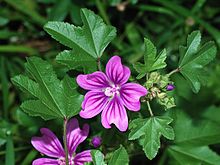
Malva sylvestris

Malva sylvestris is a species of the mallow genus Malva in the family of Malvaceae and is considered to be the type species for the genus. Known as common mallow to English-speaking Europeans,it acquired the common names of cheeses, high mallow and tall mallow (mauve des bois by the French)as it migrated from its native home in Western Europe, North Africa and Asia through the English-speaking world. M. sylvestris is a vigorous plant with showy flowers of bright mauve-purple, with dark veins, standing 3–4 feet (0.91–1.22 m) high and growing freely in meadows, hedgerows and in fallow fields. It is one of several species of different genera sometimes referred to as Creeping Charlie, a term more commonly applied to Glechoma hederacea (ground ivy). Malva sylvestris is a spreading herb,which is an annual in North Africa,biennial in the Mediterranean and a perennial elsewhere. It can be straight or decumbent, branched, and covered with fine soft hairs or none at all, M. sylvestris is pleasing in appearance when it first starts to flower, but as the summer advances, 'the leaves lose their deep green color and the stems assume a ragged appearance'. The leaves are borne upon the stem, are roundish, with numerous lobes, each 2–4 centimetres (0.79–1.57 in) long, 2–5 centimetres (0.79–1.97 in) and 5–10 centimetres (2.0–3.9 in) in diameter. The leaves have hairs radiating from a common center, with prominent veins on the underside. Described as reddish-purple, bright pinkish-purple with dark stripes and bright mauve-purple, the flowers of Malva sylvestris appear in axillary clusters of 2 to 4 and form irregularly and elongated along the main stem with the flowers at the base opening first. M. sylvestris has an epicalyx (or false calyx) with oblong segments, two-thirds as long as calyx or 2–3 millimeters long and 1.5 millimeters wide. Its calyx is free to the middle, 3–6 millimeters long, with broadly triangular lobes or ovate mostly 5–7 millimeters long. The flowers are 2–4 times as long as the calyx; Nutlets strongly reticulate (10–12 mericarps, usually without hair, with sharp angle between dorsal and lateral surfaces, 5–6 mm in diameter.
